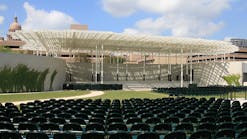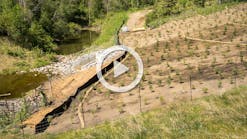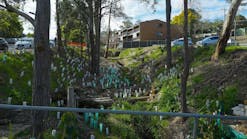Editor’s note: This article first appeared in the January/February 2016 issue of Erosion Control.
Indiana Streetscapes
In August, Woodruff & Sons in Michigan City, IN, began working on a streetscape project in which the curbs and sidewalks are being taken out on Wabash Street in Michigan City and the center median is being reconstructed with trees and landscaping featuring various flowers and plant material.
The project will feature a number of rain gardens that will not only serve as a decorative improvement but also be the focus of erosion control efforts, notes Todd Bell, vice president of Woodruff & Sons.
The project was designed by Ryan Laughlin, a design engineer with Hass & Associates in Michigan City. It began merely as a project to remove trees affected by the emerald ash borer from the median.
“The Alliance for the Great Lakes made it apparent to us that there would be some federal grant money available to do stormwater infrastructure, and that’s when the project grew to include 27 rain gardens,” says Laughlin. “From there, it grew to include some other amenities and plant elements that were called for in the Lake Michigan Gateway Implementation Strategy, which is a master plan for the north end of Michigan City.”
Laughlin says the soils drain well because the area is so close to Lake Michigan and the dunes, and therefore well suited for rain gardens.
“Before we had the rain gardens in, everything was draining straight into the gray infrastructure in the way of storm sewers and getting taken rapidly into Trail Creek, which is a heavily used natural resource and recreational area for a lot of people. This was a great opportunity to help clean that up in a transparent way so people will be able to understand what’s going on.”
Bell says his company is saw-cutting the existing pavement; removing the existing curbs and sidewalks to put new ones in; taking out the median; putting in irrigation, trees, and plantings; and installing the rain gardens.
The area’s traffic was one of the biggest challenges, both men agree. Some of the construction work is taking place next to the Lighthouse Place Premium Outlets, “which is a major stakeholder in the Michigan City area,” notes Laughlin. “There are five million people a year who go into that place, so the traffic around there is tricky, but other than that, the project has been pretty smooth.”
Bell says the traffic is confined to a single lane in each direction so Woodruff & Sons can do its work.
Woodruff & Sons is using inlet covers from Blocksom & Co., which manufactures natural fiber products. The company’s Storm Water Inlet Filter is designed to provide optimal sediment control at sewer inlets during the construction phase.
“The job is 3,000 feet long from 11th Street to Highway 12, so there’s probably nine or 10 blocks there and quite a few inlets,” notes Bell.
Laughlin says the inlet filters are “quite durable and easy to install. Particularly at this site, we didn’t have a need for other BMPs because everything is draining into the right of way and into the road, then into the existing gray infrastructure, so that’s the only implementation we needed to do.
“The contractors like the filters because if they do get clogged up, they can just spray them out and reattach them. They don’t have to reach in and pull out devices and dump them out,” he adds.
The Storm Water Inlet Filter mat is cut to allow 3 inches of overlap at each side of the inlet grate. It is then attached to the top side of the inlet grate using cable ties.
For maintenance following each rain event, silt is cleaned from around the inlet mat. Built-up silt and solids are removed by sweeping the top of the mat.
The Wabash Street project is expected to be completed in the spring.






